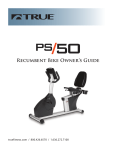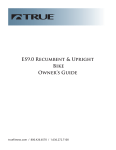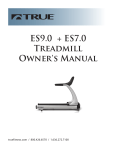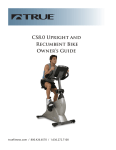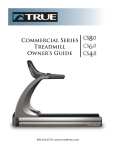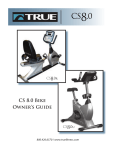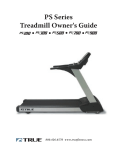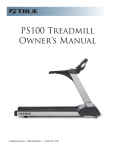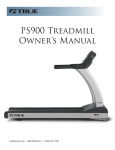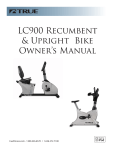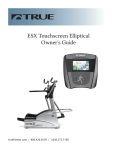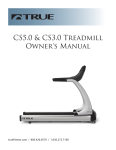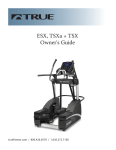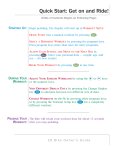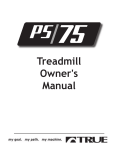Download True Manufacturing Company Z5.4 User's Manual
Transcript
Z5.4 & Z5 Treadmill Owner's Manual truefitness.com / 800.426.6570 / 1.636.272.7100 Thank You For Selecting True In 1981, Frank Trulaske launched TRUE Fitness®, and began manufacturing premium hand-crafted treadmills. His team’s obsession with quality has propelled TRUE to the top of the fitness industry and has created one of America’s oldest, largest and most respected fitness equipment manufacturers. While TRUE has expanded its line of products, intensive quality control standards guarantee excellence in every phase of production. This results in the finest products available in the marketplace. “Our original goal was to build the world’s best fitness equipment, and today we believe we’re doing it!” TRUE is the choice for cardio workouts among beginners, rehab patients and top athletes worldwide. Over the years, TRUE -Frank Trulaske has designed, developed, Today TRUE Fitness patented and fabricated offers a full line of many new cutting-edge premium elliptical innovations for their products. Such trainers, treadmills, upright and advancements include groundrecumbent bikes, and flexibility breaking new features, state-of-theequipment. art manufacturing components, and technological breakthroughs. Review for Your Safety Important Safety Instructions When using this exercise machine, basic precautions should always be followed, including the following: Read and understand all instructions and warnings prior to use. Obtain a medical exam before beginning any exercise program. If at any time during exercise you feel faint, dizzy, or experience pain, stop and consult your physician. Obtain proper instruction prior to use. Inspect the treadmill for incorrect, worn, or loose components and do not use until corrected, replaced, or tightened prior to use. Do not wear loose or dangling clothing while using the treadmill. Care should be used when stepping on or off the treadmill. Read, understand, and test the emergency stop procedures before use. Disconnect all power before servicing the treadmill. Do not operate electrically powered treadmills in damp or wet locations. Z5.4 & Z5 Treadmill Owner’s Guide 3 Review for Your Safety Important Safety Instructions Do not exceed maximum user weight of 400 lbs. Keep the top side of the moving surface clean and dry. Keep children and animals away. This treadmill is intended for residential use only. All exercise equipment is potentially hazardous. If attention is not paid to the conditions of equipment usage, death or serious injury could occur. Keep the rear of the treadmill at least 39” away from the wall or other obstructions. Keep the sides of the treadmill at least 20” away from the wall or other obstructions. Z5.4 & Z5 Treadmill Owner’s Guide 4 Quick Start Quick Start into a manual workout by pressing , or set up a different workout by selecting a workout and adjusting settings if necessary. Use keys, or numeric keys and press to accept each setting. Press Before Your Workout to begin your workout. Adjust speed or incline at any time by using the dedicated speed During Your and incline keys, pressing to accept your adjustment. Workout Change data readouts by pressing . Pause your workout by pressing . Z5.4 & Z5 Treadmill Owner’s Guide 5 Table of Contents Quick Start .....................................................................................5 1. Basic operation (except console)............................................8 2. Console Operation....................................................................20 3. Heart Rate Control....................................................................22 Foolproof heart rate feedback workouts 4. User Workouts...........................................................................32 How to record and run User Workouts 5. Gerkin Fitness Test....................................................................34 6. Designing an Exercise Program..............................................37 7. Care and Mainenance...............................................................45 Appendix A.....................................................................................53 Maximum Heart Rate + Target Heart Rate Appendix B......................................................................................55 Treadmill Specifications Specifications/Features/Software are subject to change Z5.4 & Z5 Treadmill Owner’s Guide 6 Starting And Stopping the Treadmill Safely Place your feet on the straddle covers. Attach the safety lanyard to your waistband. Place the safety key on the key holder. Set up your workout (see Chapter 1) and press . Stop the treadmill by reducing speed to 2 mph, then press . Z5.4 & Z5 Treadmill Owner’s Guide 7 Chapter One Basic Operation In This Chapter: Using The Keyboard Manuals & Quick Workouts Other Settings Heart Rate Monitoring Contact Heart Rate Classic Pre-Set Workouts Goal Focused Workouts Chapter 1: Basic Operation Chapter 2: Console Operation Chapter 3: Heart Rate Control Chapter 4: User Workouts Chapter 5: Gerkin Fitness Test Chapter 6: Designing an Exercise Program Chapter 7: Care and Maintenance Using the Keyboard Chapter One: Basic Operation Selecting Workouts: Press any of the workout keys and press to begin your workout using the default settings. Before pressing , you may adjust other settings like Workout Time and Body Weight, pressing after adjusting each setting. Press at any time to begin your workout. Note that HRC and workouts require settings adjustments. Adjusting Settings: Use the numeric keypad and the keys, to adjust numeric settings. Press to accept each settings adjustment. Primary Controls: During your workout, press the treadbelt and pause your workout. Press to resume your workout. Press and hold clear your workout. Change Data Display: During your workout, press change the data displayed. to stop to to Safety Lanyard: This magnetized cord must be in place on the treadmill balance bar location, and should be attached to your clothing. The treadmill will not operate if the lanyard is not attached. Z5.4 & Z5 Treadmill Owner’s Guide 9 Manual & Quick Workouts Chapter One: Basic Operation Press Quick Start: Start the treadbelt at 0.5 mph at the default workout time of 30 minutes. Manual Operation Details Setting Time or Distance Targets: Enter your weight and press . Now either enter a workout time and press , or press to be prompted for a target distance. You can keep adjusting your workout setup by repeatedly pressing . Your workout starts only when you press mph. . Quick Workouts : Press this single key to quickstart the treadmill to 3 : Press this single key to quickstart the treadmill into the walk segment of Level 8 Speed Intervals, alternating between 3 & 6 mph in one-minute increments. : Quick Starts treadmill to 6 mph. : Press the Cool Down key to exit your workout into a walk. The cool-down speed at 0% grade is calculated to be 40% of your average workout intensity or 2.5 mph, whichever is lower. Z5.4 & Z5 Treadmill Owner’s Guide 10 Other Settings Chapter One: Basic Operation Important: Quick speed keys change speed with a single key press, so take care in the keys you press. Quick Speed Press , lighting the enable LED. Now the numeric keys function as speed change keys from 1 mph to 9 mph. Quickspeed is functional in any workout except fitness tests and Heart Rate Control. Disable QuickSpeed by pressing again. During workout set up, set a correct body weight including clothes Body Weight so the treadmill can better estimate your calorie expenditure. Z5.4 & Z5 Treadmill Owner’s Guide 11 Heart Rate Monitoring Chapter One: Basic Operation This treadmill can monitor your heart rate using either the chest strap provided with the treadmill or the metal grips on the hand rails (called contact heart rate or CHR pads). A chest strap transmits your heart rate to the treadmill via radio, and the CHR pads connect to a special computer circuit to extract your heart rate. Although this treadmill functions fine without using the heart rate monitoring feature, this kind of monitoring gives you valuable feedback on your effort level. Chest strap monitoring also allows you to use Heart Rate Control, the most advanced exercise control system available. Chest Strap Heart Rate Monitoring When you wear a Polar® or compatible transmitter strap, the treadmill will display your heart rate as a digital beats-perminute (bpm) readout. The transmitter strap should be worn directly against your skin, about one inch below the pectoral muscles/breast line (see picture). Women should be careful to place the transmitter below their bra line. Some moisture is necessary between the strap and your skin. Sweat from your exercise works best, but ordinary tap water may be used prior to your workout if desired. Z5.4 & Z5 Treadmill Owner’s Guide 12 Contact Heart Rate Chapter One: Basic Operation The contact heart rate (CHR) system lets you monitor your heart rate without wearing a strap. Gently grasp the contact heart rate pads as shown. Contact Heart Rate (CHR) When the system detects your hands, the Heart Rate label will start flashing in time with your heart beat. During this time, the system is analyzing and locking in your heart rate. Within about 15 seconds, your digital heart rate in beats per minute (bpm) should be displayed. Important: The CHR System should only be used at speeds of 4 mph or lower. Above this speed the CHR accuracy is unavoidably unreliable due to large muscle movements. Z5.4 & Z5 Treadmill Owner’s Guide 13 Contact Heart Rate Chapter One: Basic Operation .1. Exercise with smooth body motions. 2. Breathe smoothly and regularly, and avoid talking. (Talking will cause unrepresentative heart rate spikes of 5 to 10 bpm.) For Best CHR Results 3. Grip the pads lightly, not tightly. 4. Make sure your hands are clean, free of both dirt and hand lotions. 5. See Appendix A for more details on Contact Heart Rate monitoring. When using a Heart Rate Control workout, it is best to use chest strap monitoring. These workouts work best with the extra accuracy gained from a chest-contact heart rate monitoring system. Z5.4 & Z5 Treadmill Owner’s Guide 14 Contact Heart Rate Chapter One: Basic Operation A Note on CHR Accuracy CHR monitoring may be a bit less accurate than a chest strap, since the heart rate signals are much stronger at the chest. About 5% of the population cannot be picked up by any CHR system. This is because their heart is positioned in a more up-and-down manner in their chest, as opposed to leaning over to one side. Z5.4 & Z5 Treadmill Owner’s Guide 15 Classic Pre-Set Workouts Chapter One: Basic Operation These are TRUE’s original four pre-set workouts. Changing the workout time stretches and compresses the workout profile. Other differences are explained below in the individual workout sections. Incline changes in varying amounts; the new Hills workout has hills of the same size all throughout the workout. Glute Buster Very similar to Hill Intervals, with varying incline changes. Leg Shaper Similar to Speed Ramp, except both speed and grade change. Cardio Challenge = Incline = Speed Z5.4 & Z5 Treadmill Owner’s Guide 16 Classic Pre-Set Workouts Chapter One: Basic Operation Sports Training When the treadmill is changing to a new target speed, the matrix display readout will display the actual speed. As the speed is changing, the message center will display TARGET = 12.0 MPH Actual Speed Display Once the treadmill reaches the new target speed, the Speed readout will show the target speed. Z5.4 & Z5 Treadmill Owner’s Guide 17 Goal Focused Workouts Chapter One: Basic Operation Your Z Series treadmill also comes with advanced workouts options for thise lookign to get the most out of their training. Quick Workout Keys [walk, walk+run, run] Use these keys to set up your favorite training speeds. Quick workout Keys While the treadmill is operating in manual mode, pressing and holding either the walk or run key will “save” that speed as that key’s operating speed. Pressing that key will change the treadmill speed to that speed. Note: you can’t set a higher speed for the walk key than is set in the run key. Tip: set the walk key speed first. The walk+run key uses the speeds set in the walk and run keys in an interval workout pattern. It alternates every 60 seconds between the walk speed and the run speed. Before you customize these keys, the walk key is set to 3 mph, and the run key is set to 6 mph. Caution: just a single keypress of these keys will change the treadmill speed. Z5.4 & Z5 Treadmill Owner’s Guide 18 Goal Focused Workouts Chapter One: Basic Operation Weight Loss By pressing the “Weight Loss” key, users have the option of choosing one of three separate programs that assist users in achieving their weight loss goals. These programs are: Weight Loss Leg Shaper (See Page 16) Sports Training (See Page 17) HRC (See Chapter 3) Performance Performance By pressing the “Weight Loss” key, users have the option of choosing one of three separate programs that assist users in achieving their weight loss goals. These programs are: Glute Buster (See Page 16) Cardio Challenge (See Page 16) Z5.4 & Z5 Treadmill Owner’s Guide 19 Chapter Two Console Operation Chapter 1: Basic Operation Chapter 2: Console Operation Chapter 3: Heart Rate Control Chapter 4: User Workouts Chapter 5: Gerkin Fitness Test Chapter 6: Designing an Exercise Program Chapter 7: Care and Maintenance Console Operation Chapter Two: Keyboard/Console Z5.4 & Z5 Keyboard/ Console Z5.4 & Z5 Treadmill Owner’s Guide 21 chapter three Heart Rate Control In This Chapter: HRC Introduction HRC Types and Workout Guide Workout Setup During Your Workout Tips & How HRC Works Examples & Cruise Control Examples of Walking & Running Workouts Important Points About HRC HRC Safety Chapter 1: Basic Operation Chapter 2: Console Operation Chapter 3: Heart Rate Control Chapter 4: User Workouts Chapter 5: Gerkin Fitness Test Chapter 6: Designing an Exercise Program Chapter 7: Care and Maintenance HRC Introduction Chapter Three: HRC Workouts TRUE’s heart rate control (HRC) workouts let the treadmill monitor your relative exercise intensity by way of your heart rate, then automatically adjust the workload to keep you at your target heart rate and thus your desired exercise intensity. Your heart rate is a good measure of your body’s exercise stress level. It reflects differences in your physical condition, how tired you are, the comfort of the workout environment, even your diet and emotional state. Using heart rate to control workload takes the guesswork out of your workout settings. Consult your physician before using heart rate controlled workouts for advice on selecting a target heart rate range. Also, it is important to use the treadmill for several workouts in the manual mode while monitoring your heart rate. Compare your heart rate with how you feel to ensure your safety and comfort. See Appendix A for a chart that may help you pick a target heart rate. You need to wear a heart rate monitoring chest strap to use heart rate control. See the “Monitoring Your Heart Rate” section in Chapter 1 for a guide to proper usage. It is not recommended that you use the contact heart rate system for heart rate control workouts. Z5.4 & Z5 Treadmill Owner’s Guide 23 HRC Types & Workout Guide Chapter Three: HRC Workouts Various types of Heart Rate Control (HRC) are available on the Z5.4 & Z5 treadmills. Cruise Control: while in any workout, set your current heart rate as your target heart rate by pressing the key. Time-based constant HRC: pick a target heart rate and exercise for an amount of time you select. 1 - Put on a Polar® or compatible transmitter chest strap as described in section Chapter 1. 2 - Press the key until you reach your desired workout, then press . 3 - Enter your workout parameters. This includes target heart rate, maximum treadbelt speed, workout time or distance, and maximum incline. If you are using Interval HRC, pick your interval durations, too. 4 - Press . Easy Steps to a HRC Workout Z5.4 & Z5 Treadmill Owner’s Guide 24 Workout Setup Chapter Three: HRC Workouts 5 - Warm up. At the beginning of an HRC workout, the treadmill is in full Manual Control mode. Gradually increase your work level to slowly raise your heart rate to within 10 beats per minute (bpm) of your target heart rate. 6 - Heart rate control stage. Now the treadmill takes control of speed and incline, keeping your heart rate within a few bpm of your target. If you are using interval HRC, the treadmill alternates between work and rest intervals. 7 - Cool-down. At the end of your workout time or distance, the treadmill reduces workload by half and goes back into Manual Control mode, where you directly control your cool-down. Your treadmill can remember more than one workout setup for a heart rate control workout. You can select these in later workouts so you don't have to re-enter your workout parameters, which tend to stay the same from workout to workout. During workout setup, if you keep pressing , you will continue to scroll through the workout setup parameters You can press at any time to accept the current parameters and begin your workout. During Workout Setup Z5.4 & Z5 Treadmill Owner’s Guide 25 During Your Workout Chapter Three: HRC Workouts • Pressing any key other than mode. or will exit HRC During Your Workout • Adjust your target heart rate at any time during your workout by pressing , using the keys as needed, and pressing again. If you are lowering your target, you are limited to a 5 bpm change. • The time and distance accumulated during warm up are not counted against your selected workout time or distance; those values start at zero when the treadmill reaches heart rate control mode. This time and distance are accumulated into the workout summary data, as is your cooldown exercise. Z5.4 & Z5 Treadmill Owner’s Guide 26 Tips and How HRC Works Chapter Three: HRC Workouts The treadmill operates in a manual control mode during the warm-up stage. You control both speed and incline. You may only increase speed and incline to the preset maximum values entered. Tips on the Warm Up Stage Increase speed and incline gradually to slowly increase your heart rate to within 10 bpm of your target. For best results, you should take about five minutes to get to that point. It is important that you start at a low level of effort and gradually increase your work load over several minutes until you approach your target heart rate. This allows your body to adapt to your workout. Increasing work load gradually will allow you to enter the heart rate control stage without overshooting your target. Warming up too fast may cause you to overshoot your target. If this occurs, it may take several minutes before the computer software can control your heart rate. You may overshoot and undershoot your target for several minutes until stable control is achieved. How the HRC System Controls your Heart Rate To raise your heart rate in HRC mode, speed will always increase until maximum speed is attained, followed by incline (if incline is used in the workout). To lower your heart rate in the HRC mode, incline will always decrease until zero incline is reached, followed by speed (if incline is used in the workout). Speed changes are in 0.1 mph increments. Incline changes are in 0.5% incline increments. This is equal to between 0.10 and 0.15 METs. Z5.4 & Z5 Treadmill Owner’s Guide 27 Examples and Cruise Control Chapter Three: HRC Workouts 1 - A user who physically cannot walk over 2.5 mph can safely use heart rate control by entering maximum speed of 2.5 in an HRC workout. Examples of HRC Workouts 2 - A runner can run up to a speed of 10 mph, without hills, by entering a maximum speed of 10 mph and a maximum incline of 0%. 3 - A walker enters a maximum speed of 4.0 mph and a maximum incline of 6%. The walker is limited to a maximum speed of 4.0 mph and incline will be used if required to elevate the heart rate up to a maximum of 6%. HRC Cruise Control is the simplest way to enter target heart Cruise rate training. While in manual or any program you can enter Control Target Heart Rate Control by simply pressing the key. Your current heart rate will be set as the target. For best results, you should be at least five minutes into your workout and warmed up. This will allow Cruise Control to more accurately control your heart rate. Remember, you must be wearing a chest strap, and your heart rate should be displayed in the Heart Rate window. To change your target heart rate press . Edit the target using and press . If you are lowering your target, you are limited to a 5 bpm change. It is important to note that if you are raising your target, the speed and grade change safety limits (described next) may prevent the treadmill from raising your heart rate to your desired new target. Z5.4 & Z5 Treadmill Owner’s Guide 28 More Examples Chapter Three: HRC Workouts If you enter the HRC stage below 5 mph, the speed you enter will be the maximum speed of your workout. If you like to walk at a maximum speed of 3.8 mph, you should enter HRC at 3.8 mph. If you enter the HRC stage above 5 mph, you will have an additional 1 mph of speed. If you enter HRC at 6 mph, your maximum attainable speed in the HRC stage will be 7 mph. How Cruise Control Determines Your Exercise Intensity If at any time you enter the HRC stage with incline, you will have an additional 4% of incline available in the HRC stage. If you enter the HRC stage at 1% incline, your maximum attainable incline will be 5%. If you do not enter the HRC stage with incline, no incline will be available during the HRC stage of your workout. Only speed will be used to control your heart rate. 1 - Enter HRC at 3.5 mph and 4% incline to allow a maximum speed of 3.5 mph and 8% incline. 2 - Enter HRC at 4.2 mph and 6% incline to allow a maximum speed of 4.2 mph and 10% incline. 1 - Enter HRC at 6 mph and 0% incline to allow a maximum of 7 mph and 0% incline. 2 - Enter HRC at 5 mph and 2% incline to allow a maximum of 6 mph and 6% incline. Examples of Walking Workouts Using Cruise Control Examples of Running Workouts Using Cruise Control Z5.4 & Z5 Treadmill Owner’s Guide 29 Important Points About HRC Chapter Three: HRC Workouts The heart rate monitor transmitter strap provided with your treadmill should be worn directly against your skin at about one inch below the pectoral muscles/breast line. Women should be careful to place the transmitter below their bra line. Some moisture is necessary between the strap and your skin. Sweat from your exercise works best, but ordinary tap water may be used prior to your workout if desired. Important Points About Heart Rate Control If the transmitter strap is adjusted or moved while exercising, communication may be temporarily affected. If communication is lost for 30 seconds, the treadmill will automatically shut off. The transmitter strap sends a low-level radio signal to the treadmill, so interference from other radio and sound waves (including everything from cordless telephones to loudspeakers) is possible. The good news is that interference is usually quite brief. If you continue to have intermittent heart rate display problems, consult your local service technician, as the transmitter strap batteries may be low. Make sure you breath smoothly and regularly. Talking during your workout usually causes heart rate spikes of five beats per minute or more, so avoid talking as much as possible. Maintain a smooth walking or running motion. A grounded outlet is critical for the HRC system to function properly. Use a dedicated 115 VAC, grounded outlet to help prevent interference. Z5.4 & Z5 Treadmill Owner’s Guide 30 HRC Safety Chapter Three: HRC Workouts Two users wearing the same kind of transmitter at the same time Technical and in close proximity may cause false heart rate display readings. Tips Use only the transmitter provided with your TRUE HRC treadmill or a Polar® brand standard transmitter. TRUE’s Heart Rate Control is patented under USPTO #5,462,504. If your heart rate exceeds your target by 12 beats, there will be a 30% MET reduction in workload to reduce your heart rate. If your heart rate exceeds your target by 20 beats, the unit will automatically shut off as a precautionary measure. (Be cautious when selecting your target heart rate so the 20 beat variance will not exceed your maximum heart rate as determined by your physician). Heart Rate Control Safety Features Z5.4 & Z5 Treadmill Owner’s Guide 31 Chapter Four Custom Workouts In This Chapter: How to Record and Run User Programs Chapter 1: Basic Operation Chapter 2: Console Operation Chapter 3: Heart Rate Control Chapter 4: Custom Workouts Chapter 5: Gerkin Fitness Test Chapter 6: Designing an Exercise Program Chapter 7: Care and Maintenance How to Record and Run User Programs Chapter Four: User Workouts During a manually-controlled workout, Z5.4 & Z5 treadmills always "record" the changes you make in speed or incline. Z5.4 & Z5 treadmills can save up to two User Workouts Note that this workout recording only takes place when you use the default manual mode settings; you cannot choose a target workout time or distance. Time must count up during your workout in order to be recorded. How To Record And Run User Programs Up to 36 changes in speed or incline can be recorded. Each speed/ incline pair of changes must be separated by at least 30 seconds. To save a manual workout, press as you normally would to end your workout. Now press and hold until the display shows Save User 1. You can save your workout in User 1, or press to select User 2. Press and hold to save the workout you have selected. To use a User Workout that you have saved, simply select it from the list of workouts under the Favorites or Advanced Options Keys. Z5.4 & Z5 Treadmill Owner’s Guide 33 Chapter Five Gerkin Fitness Test In This Chapter: Your Fitness Level Accuracy of the Gerkin Fitness Test Chapter 1: Basic Operation Chapter 2: Console Operation Chapter 3: Heart Rate Control Chapter 4: Custom Workouts Chapter 5: Gerkin Fitness Test Chapter 6: Designing an Exercise Program Chapter 7: Care and Maintenance Your Fitness Level Chapter Five: Gerkin Fitness Test One way to measure your overall fitness is to take a Gerkin fitness test. Named after the Arizona researcher who designed this test, this submaximal treadmill test (submaximal means you work below maximum effort) is used to predict VO2 max: the volume of oxygen you can consume while exercising at your maximum capacity. This particular test has gained great popularity in the firefighter and law enforcement community. Like most fitness tests, it is classified as a graded exercise test (GXT). The test is stopped at the point your heart rate reaches 85% of your age-predicted maximum. Select the Gerkin test under the Advanced Options key. Enter your Using the age, which is used to calculate your test termination point. Gerkin Test The Gerkin protocol starts at 4.5 miles per hour at a 0% incline. It then increases speed or incline every 60 seconds. For example, at the seven-minute mark, the speed increases to 6 miles per hour while the incline raises to 8%. When your heart rate reaches 85% of your age-predicted maximum, the test waits for your heart rate to exceed the target for 15 seconds, then terminates the test. The version of the Gerkin Protocol that TRUE Fitness uses in its exercise machines is the new equation of 205.8 – 0.685*age. To better understand why we selected this method over the outdated “220 – age” maximal heart rate equation, you can review the scientific paper in Journal of Exercise Physiology, a PDF document located at http://asep.org/Documents/ Robergs2.pdf Z5.4 & Z5 Treadmill Owner’s Guide 35 Accuracy of the Gerkin Test Chapter Five: Gerkin Fitness Test The scientific journal, Occupational Medicine, published a study in 2004 on the accuracy of the Gerkin test. The conclusion: “The Gerkin treadmill protocol overpredicts VO2max in healthy men and women and, therefore, should not be used for predicting VO2max in individual firefighters, particularly if VO2max is a criterion for inclusion or exclusion from duty. At this time, a valid treadmill running test is needed for predicting the VO2max value of individual firefighters.” Accuracy of the Gerkin Test However, for the fitness enthusiast who is interested in monitoring their fitness level, the Gerkin test can be used to measure progress over time. Z5.4 & Z5 Treadmill Owner’s Guide 36 chapter six Designing an Exercise Program In This Chapter: The F.I.T. Concept Defined F.I.T. Concept Overview Utilizing the F.I.T. Concept Beginning Your F.I.T. Program Establishing and Maintaining Fitness Weight & Sports Training Programs Chapter 1: Basic Operation Chapter 2: Console Operation Chapter 3: Heart Rate Control Chapter 4: Custom Workouts Chapter 5: Gerkin Fitness Test Chapter 6: Designing an Exercise Program Chapter 7: Care and Maintenance The F.I.T. Concept Defined Chapter Six: Designing an Exercise Program The workout portion of your exercise program consists of three major variables: Frequency, Intensity, and Time. Frequency: How Often You Exercise You should exercise three to five times a week to improve your cardiovascular and muscle fitness. Improvements are significantly smaller with less frequent exercise. Intensity: How Hard You Exercise Intensity of exercise is reflected in your heart rate. Exercise must be sufficiently rigorous to strengthen your heart muscle and condition your cardiovascular system. Only your doctor can prescribe the target training heart range appropriate for your particular needs and physical condition. Start with exercise that stimulates you to breathe more deeply. Alternate days of moderate and easy exercise to help your body adapt to new levels of exertion without unnecessary strain. If you are just beginning an exercise program, you may be most comfortable walking at a speed of 1-2 mph. As you use your treadmill regularly, higher speeds may be more comfortable and more effective. Inability to maintain a smooth, rhythmic motion suggests that your speed and/or elevation may be too great. If you feel out of breath before you have exercised 12 minutes, you are probably exercising too hard. Z5.4 & Z5 Treadmill Owner’s Guide 38 F.I.T. Concept Overview Chapter Six: Designing an Exercise Program As your fitness level improves, you will need to increase your workout intensity in order to reach your target heart rate. The first increase may be necessary after two to four weeks of regular exercise. Never exceed your target heart rate zone. Increase the speed and/or incline on the treadmill to raise your heart rate to the level recommended by your doctor. The incline feature can be used to greatly increase the workload without increasing speed. METs One MET is the amount of energy your body uses when you're resting. If a physical activity has an equivalent of 6 METs, its energy demands are 6 times that of your resting state. The MET is a useful measurement because it accounts for differences in body weight. See Appendix C for more details. Time: How Long You Exercise Sustained exercise conditions your heart, lungs, and muscles. The longer you are able to sustain exercise within your target heart range, the greater the aerobic benefits. To begin, maintain two to three minutes of steady, rhythmic exercise and then check your heart rate. The initial goal for aerobic training is 12 continuous minutes. Increase your workout time approximately one or two minutes per week until you are able to maintain 20-30 continuous minutes at your training heart rate. Z5.4 & Z5 Treadmill Owner’s Guide 39 Utilizing the F.I.T. Concept Chapter Six: Designing an Exercise Program The F.I.T. concept and chart are designed to help you begin a program tailored to your needs. You may wish to keep an exercise log to monitor your progress. Using the F.I.T. Concept You can get valuable fitness benefits from your TRUE treadmill. Using the treadmill regularly may increase the ability of your heart and lungs to supply oxygen and nutrients to exercising muscles over an extended period of time. The treadmill will also help you develop added muscle endurance and balanced strength throughout your body. Your Fitness Program Calculate your maximum heart rate as a first step in developing your fitness program. The formula to calculate average maximum heart rate for one minute is 220 beats per minute minus your age. To find your pulse, locate a vein on your neck or inside your wrist, then count beats for ten seconds, then multiply by six. (See chart in Appendix A.) Determining Your Needs It's also important to know your target training zone or target heart rate. The American Heart Association (AHA) defines target heart rate as 60-75 percent of your maximum heart rate. This is high enough to condition, but well within safe limits. The AHA recommends that you aim for the lower part of the target zone (60 percent) during the first few months of your exercise program. As you gradually progress you can increase your target to 75 percent. According to the AHA, "Exercise above 75 percent of the maximum heart rate may be too strenuous unless you are in excellent physical condition. Exercise below 60 percent gives your heart and lungs little conditioning." Z5.4 & Z5 Treadmill Owner’s Guide 40 Beginning Your F.I.T. Program Chapter Six: Designing an Exercise Program In addition to monitoring your heart rate as you exercise, be certain of how quickly your heart rate recovers. If your heart rate is over 120 beats per minute five minutes after exercising, or is higher than normal the morning after exercising, your exertion may be too strenuous for your current level of fitness. Reducing the intensity of your workout is recommended. The age-adjusted target heart rates indicated in the chart in Appendix A reflect averages. A variety of factors (including medication, emotional state, temperature, and other conditions) can affect the exercise heart rate appropriate for you. Warning: Consult your doctor to establish the exercise intensity (target heart rate zone) appropriate for your age and condition before beginning any exercise program. Warm-Up: Slow and Deliberate Exercise You are not warmed up until you begin to perspire lightly and breath more deeply. Warming up prepares your heart and other muscles for more intense exercise and helps you avoid premature exhaustion. Begin each workout by walking even if you plan to run. Start slowly, exploring different speeds until you can comfortably sustain your speed. Beginning Your Exercise Program A good suggestion is a minimum of three minutes. Perspiration on your brow is a good indicator of a thorough warm-up. The older you are, the longer your warm-up period should be. Z5.4 & Z5 Treadmill Owner’s Guide 41 Your F.I.T. Program Continued Chapter Six: Designing an Exercise Program Workout: Brisk and Rhythmic Exercise The workout trains and conditions your heart, lungs, and muscles to operate more efficiently. Increase exercise in response to your heart rate to train and strengthen your cardiovascular system. Concentrate on moving your arms and legs smoothly. Walk naturally and avoid jerking motions that can cause pulled muscles, sprained joints, and loss of balance. Cool-Down: Slow and Relaxed Exercise Cooling down relaxes your muscles and gradually lowers your heart rate. Slowly reduce your workload until your heart rate is below 60 percent of your maximum heart rate. The cool down should last at least five minutes, followed by some light stretching to enhance your flexibility. Beginning a Fitness Program If you cannot sustain 12 continuous minutes in your target heart rate zone, exercise several times a week to get into the habit of exercising. Try to reach and maintain 60-65 percent of your maximum heart rate. Alternate exercise with periods of rest until you can sustain 12 continuous minutes of exercise at 60-65 percent of your maximum heart rate. Begin exercising in three to five minute sessions. Z5.4 & Z5 Treadmill Owner’s Guide 42 Establishing and Maintaining Fitness Chapter Six: Designing an Exercise Program If you can sustain 12 but not 20 continuous minutes of exercise in your target heart rate zone: Exercise three to five days a week. Establishing Aerobic Fitness Rest at least two days per week. Try to reach and maintain 60-75 percent of your maximum heart rate with moderate rhythmic exercise. Begin with 12 continuous minutes. Increase your time by one to two minutes per week until you can sustain 20 continuous minutes. If you can sustain 20 continuous minutes in your target heart rate zone, begin to increase the length and intensity of your workout: Exercise four to six days a week or on alternate days. Maintaining Aerobic Fitness Try to reach and maintain 70-85 percent of your maximum heart rate with moderate to somewhat hard exercise. Exercise for 20-30 minutes. Consistent aerobic exercise will help you change your body composition by lowering your percentage of body fat. If weight loss is a goal, combine an increase in the length of your workouts with a moderate decrease in caloric intake. For weight control, how long and how often you exercise is more important than how hard you exercise. Managing Weight Exercise four to five times a week. Z5.4 & Z5 Treadmill Owner’s Guide 43 Weight & Sports Training Programs Chapter Six: Designing an Exercise Program Try to reach and maintain 60-75 percent of your maximum heart rate with moderate exercise. Exercise for 30-45 minutes at 60-65 percent of your target heart rate. Here are some tips to achieving your weight management goal: Consume most of your dietary calories at breakfast and lunch, and eat a light dinner. Do not eat close to bedtime. Exercise before meals. Moderate exercise will help suppress your appetite. Take exercise breaks throughout the day to help increase metabolism (calorie expenditure). When you are training to improve strength and performance: Sports Training Exercise four to five days a week. Alternate exercise days and intervals of hard to very hard exercise with easy to moderate exercise. Exercise for 30 minutes or longer. Warning: these strategies are intended for average healthy adults. If you have pain or tightness in your chest, an irregular heartbeat, shortness of breath or if you feel faint or have any discomfort when you exercise, stop! Consult your physician before continuing. Remember, every workout should begin with a warm-up and finish with a cool-down. Z5.4 & Z5 Treadmill Owner’s Guide 44 chapter seven Care and Maintenance In This Chapter: Lubrication & Cleaning Treadbelt Adjustment Treadbelt Tension Chapter 1: Basic Operation Chapter 2: Console Operation Chapter 3: Heart Rate Control Chapter 4: Custom Workouts Chapter 5: Gerkin Fitness Test Chapter 6: Designing an Exercise Program Chapter 7: Care and Maintenance Lubrication and Cleaning Chapter Seven: Care and Maintenance Your TRUE treadmill is constructed of quality materials and manufactured to provide many years of faithful service. Simple routine cleaning and a preventive maintenance program will extend the life of your treadmill. To prevent electrical shock, be certain the treadmill is turned off and unplugged from the electrical outlet before performing any cleaning or routine maintenance. For average use of your treadmill, TRUE recommends you lubricate under the treadbelt once per year. For heavy use, which is more than 10 hours per week, TRUE recommends lubricating every three months. Treadbelt Lubrication The TRUE treadmill you have purchased is designed with a premium orthopedic belt. This belt provides additional comfort and cushioning. Please note that your exercise regimen/activity may require you to lubricate the belt with approved TRUE Fitness lubrication more frequently than a traditional belt for premium performance. Please contact your dealer to obtain the proper lubricants. Daily: Perspiration should be wiped from the control console and treadmill surfaces after your workout. Regular Cleaning Weekly: You should wipe down your treadmill once a week with a water dampened, soft cloth. Be careful not to get excessive moisture between the edge of the overlay panel and the console, as this might create an electrical hazard or cause the electronics to fail. Important: do not clean or wipe under the running belt. Z5.4 & Z5 Treadmill Owner’s Guide 46 Treadbelt Adjustment Chapter Seven: Care and Maintenance Monthly: Clean dust and dirt that might accumulate under and behind your treadmill once a month. Small rubber particles from the soles of walking shoes will accumulate alongside the belt and also behind the unit. Regular Cleaning Expert service and maintenance at a reasonable cost are available through your factory-trained, authorized TRUE dealer. The dealer maintains a stock of repair and replacement parts and has the technical knowledge to meet your service needs. Expert Service Your treadmill's running belt has been properly aligned at the factory. However, when the treadmill is used on an uneven surface, please follow these instructions: Treadbelt Adjustment 1 - Stand beside the treadmill, place the safety key onto the control panel and follow operating instructions for running the treadmill at 5 mph. 2 - If the belt is off-center to the right, turn the left roller adjustment bolt counter clock-wise 1/4 turn. If the belt is off-center to the left, turn the left roller adjustment bolt 1/4 turn clockwise. 3 - Let the machine run for several minutes to check the alignment. (Belt alignment does not need to be perfect). If more correction is needed, turn the adjustment bolt 1/4 turn and check again. Z5.4 & Z5 Treadmill Owner’s Guide 47 Treadbelt Tension Chapter Seven: Care and Maintenance Turn both rear roller adjustment bolts counter-clockwise until treadbelt just begins slipping when walking on it, then turn both rear roller adjustment bolts clockwise in equal quarter turn increments until treadbelt stops slipping. Note: Be sure to run on treadbelt to ensure that the treadbelt does not slip while under load. Z5.4 & Z5 Treadmill Owner’s Guide 48 Symptom/Solution Guide Chapter Seven: Care and Maintenance SYMPTOM Circuit breaker on treadmill trips when the power cord is plugged into wall. Circuit breaker on treadmill trips when inputting speed and starting CAUSE SOLUTION A. Damaged motor Service required B. Damage or defective motor power supply board Service required C. Damaged motor control circuit board Service required D. Restricted belt or Check and remove obstruction or call dealer flywheel E. Treadbelt over tensioned See adjustments in Assembly Guide A. No power to treadmill Restore power at electrical outlet or reset circuit breaker if in “on/ off ” position. B. Circuit breaker trip Reset Circuit Breaker C. Upper wire harness not connected or completely connected. Service required Incline Motor and tread motor will not turn on Incline motor does not operate but the treadbelt moves Scrambled digits on computer LED’s A. Upper wire harness damaged or not connected or completely connected Service required A. Incline wire harness damaged or not connected Service required A. Damaged computer board Service required B. Upper wire harness damaged or partially connected Service required Squeaking noise from motor while using the treadmill A. Poly V-belt slipping Service required B. Motor brush noise excessive Service required Computer display LED’s do not illuminate. Z5.4 & Z5 Treadmill Owner’s Guide 49 Symptom/Solution Guide Chapter Seven: Care and Maintenance SYMPTOM Treadbelt tracks left to right Treadmill trips household circuit breaker Treadbelt feels unsmooth, jerks intermittently CAUSE SOLUTION A. Uneven floor Move treadmill to even surface or level with shims. See Adjustment section. B. Rear roller not properly adjusted See Adjustment section. A. Defective breaker Replace breaker B. Circuit too small Use 20 amp circuit C. Circuit over-loaded Remove the other electrical appliances on same circuit D. May trip GFI circuit. Have circuit checked by electrician. A. Object between belt and deck Remove object between belt and deck B. Object under belt Remove object from under belt C. Loose tread motor drive belt Service required D. Loose treadbelt tension See Adjustment section. Z5.4 & Z5 Treadmill Owner’s Guide 50 Error Codes Chapter Seven: Care and Maintenance E1:INCLINE Incline moving when not commanded to. E1:RANGE Difference between zero position and maximum incline not sufficient. E1:STALL Incline not moving when commanded to. E2:OVERSPEED This error occurs when an acceleration of greater than 2.1 mph occurs. Error cleared by turning off power switch then turning it back on. E2:CAL Treadmill cannot achieve target speed. Re-calibrate treadmill. E3:RECAL This error occurs when a data error is detected in the EEPROM. Replace the control panel. Error Codes E4:KEY STK [stop] Caused by pressing and holding the stop key for more than five seconds. E5:SENSOR This message is displayed when there is no speed feedback. All errors require service by a qualified technician in order to clear the error, turn power off and back on again. Z5.4 & Z5 Treadmill Owner’s Guide 51 Service Messages Chapter Seven: Care and Maintenance The following service messages will be displayed as they occur, as well as for the subsequent six safety key insertions. These messages will be displayed until a key is pressed. Every time these messages are displayed, a tone will sound twice. S1:LUBE Diagnostics Service Messages This message is displayed when lubrication of the deck is recommended. S2:CLEAN This message is displayed every 500 miles. Prompt to clean treadmill. S3:MOTOR This message is displayed every 2500 hours. Prompt to check motor brushes. Z5.4 & Z5 Treadmill Owner’s Guide 52 appendix a Target Heart Rate Chart A Guide to Help You Pick an Initial Target Heart Rate Appendix A Target Heart Rate Chart Z5.4 & Z5 Treadmill Owner’s Guide 54 appendix b Specifications Specifications Z5.4 Motor Frame Z5 TRUE 3hp DC Robotically Welded HeavyGuage Steel HRC Cruise Control™ YES HRC Workouts 2 Target HRC Workouts 6 - Manual, Quick Start, Hill Intervals, Weight Loss, Speed Intervals, Cardio Challenge User Defined YES-2 Footprint 30" W x 68" L (76 cm x 173 cm) Running Surface 22" W x 54" L (56 cm x 137 cm) Maximum User Weight 400 lbs Soft Select YES Incline 0 to 15% Speed 0-12 mph (0-19 kph) TRUE 3hp DC Robotically Welded HeavyGuage Steel YES 2 Target HRC 6 - Manual, Quick Start, Hill Intervals, Weight Loss, Speed Intervals, Cardio Challenge YES-2 28" W x 68" L (71 cm x 173 cm) 20" W x 54" L (51 cm x 137 cm) 400 lbs NO 0 to 15% 0-12 mph (0-19 kph) Warranty Frame Lifetime, Motor 30 Years, Parts 10 Years, Labor 1 Year Frame Lifetime, Motor 30 Years, Parts 10 Years, Labor 1 Year Z5.4 & Z5 Treadmill Owner’s Guide 56 bibliography Bibliography References and Selected Readings Bibliography American College of Sports Medicine, ACSM's Guidelines for Exercise Testing and Prescription. 6th edition. Philadelphia: Lippincott Williams & Wilkins, 2000. Feynman, Richard P., The Feynman Lectures on Physics. Original edition. Boston: Addison Wesley, 1970. ISBN: 0-201-02115-3. Huszar, Robert J., Basic Dysrhythmias. Third Edition. St. Louis, Missouri: Mosby, 2002. McArdle, William D., Katch, Frank I., and Katch, Victor L., Exercise Physiology, 5th edition. Baltimore: Lippincott Williams & Williams, 2001. McMahon, Thomas A. and Bonner, John T., On Size and Life. New York: W. H. Freeman, 1985. ISBN: 0-716-75000-7. Pollack, Michael L., Gaesser, Glenn A., Butcher, Janus D., et al. (1998) The recommended quantity and quality of exercise for developing and maintaining cardiorespiratory and muscular fitness in healthy adults. (The ACSM Position Stand on Fitness.) Medicine and Science in Sport and Exercise, 30(6): 975-991. URL: <ipsapp006.lwwonline.com/content/getfile/2320/20/1050/ fulltext.htm> Other ACSM position stands are found here: <www.acsm-msse.org> Z5.4 & Z5 Treadmill Owner’s Guide 58 Bibliography Robergs, Robert A. and Landwehr, Roberto. (2002) The Surprising History of the "HRmax = 220 - age" Equation. Journal of Exercise Physiology, 5(2). ISSN 1097-9751.2 Article URL: <http://www.asep.org/Documents/Robergs2.pdf> Journal URL: <http://www.asep.org/FLDR/JEPhome.htm> Starr, Robert M. and Doyle, Jay D., 550 ZTX Owner’s Guide, Colophon edition. O’Fallon: True Fitness Technologies, 2003. Swain, David P. and Leutholtz, Brian C., Metabolic Calculations - Simplified. Baltimore: Williams & Wilkins, 1997. Tufte, Edward R, Visual Explanations. Chesire, Connecticut: Graphics Press, 1997. Whitmore, Jack H. and Costill, David L., Physiology of Sport and Exercise. 2nd edition. Champaign, Illinois: Human Kinetics, 1999. Whitt, Frank R. and Wilson, David G., Bicycling Science. Cambridge: The MIT Press, 1982. Z5.4 & Z5 Treadmill Owner’s Guide 59 F o u n d e d 1 9 8 1 865 Hoff Road St. Louis, MO 63366 800.426.6570 truefitness.com ©2008 TRUE FITNESS TECHNOLOGY, INC. TRUE is a registered trademark of TRUE FITNESS. Specifications subject to change. 092308






























































